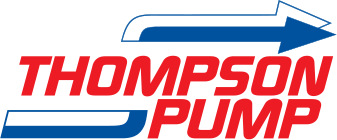Thompson Pump Bypasses the Little Cuyahoga Interceptor in Akron, OH
Thompson Pump, the industry leader in providing pumps and equipment for bypass applications, was involved in an extensive, month-and-a-half long Sewer Interceptor Bypass for the City of Akron, OH. Thompson Pump Midwest, located in Clarkston Michigan, secured the contract with Spinello Companies to oversee the design and installation of the bypass. Brian Lenaghan, president of Thompson Pump Midwest and Majid Tavakoli, vice president of Thompson Pump Corporate Office, worked with the contractor to aggressively formulate a bypass plan that would allow the bypass system to be fully operational in under eight days from the start of installation. The pump system was required to support 86.4 million gallons of sewage per day. Both Lenaghan and Tavakoli bring over 40 years of combined expertise to the industry. An installation crew of twelve from both Thompson Pump Midwest and Thompson Pump’s Corporate Headquarters in Florida, arrived on site and operated around the clock to install a pumping system that bypassed the 60-inch Little Cuyahoga Interceptor Sewer. The crew is specifically trained in fusion, assembly and installation, traveling all over the country installing projects of this magnitude on a regular basis. The system consisted of:
• Three 16” Thompson Pump Compressor-Assisted Solids-Handling High Pressure Pumps, which were used as primary units. The pumps were fitted with 18” increaser ports on the suction side in order to fit the 18” HDPE pipe directly to the suction port. The 16” pumps were each capable of a maximum capacity of 11,000-gpm at 160 maximum feet of head.
• Six 12” Thompson Pump Compressor-Assisted Solids-Handling High Pressure Pumps, which were used as secondary units and installed on an automatic starting system that started the pumps if the sewage levels increased. The 12” pumps were each capable of a maximum capacity of 8,500-gpm at 200 maximum feet of head.
• A large 120’ long, 30” manifold fabricated by Thompson Pump Midwest, which was used to divert the discharge flows from the pumps into five different 18” HDPE lines. The manifold was fitted with knife valves, which allowed the contractor to isolate the pumps within the system as required to take a pump off the line if necessary.
• Five 18” HDPE lines from the manifold, which led off the jobsite, across a street, down another street, across the entry to a church parking lot, where the next manhole was located just off the church grounds 2,560-feet from the bypass origin. A total of 12,800-feet of 18” HDPE pipe was fused together by the Thompson Pump crews and installed over the entire length of the system.
• Other equipment such as fork lifts, fuel tanker trucks, light towers, and oil trucks.
All of the pumps used on the bypass were equipped with Thompson Pump’s exclusive ENVIROPRIME® Priming System. The ENVIROPRIME® Priming System has proven to be a valuable pumping feature because of it’s ability to prevent blow-by. Blow-by occurs when pumping fluid enters the air-handling portion of the priming system and eventually leaks onto the ground. Thompson Pump engineers recognized that blow-by is a major issue on sewage bypasses and developed a modular, stand-alone priming system that prevents blow-by altogether.
The project lasted about 45 days and was a complete success thanks to expertise and manpower provided by Thompson Pump Midwest and Thompson Pump’s Corporate Office.
The manifold fabricated by Thompson Pump Midwest used to divert the flow from the pumps was equipped with 9 inputs, and 5 outputs that led to the final discharge point – 2,560 feet away from the project. The manifold was equipped with knife valves, which would allow the isolation of each pump as required.
